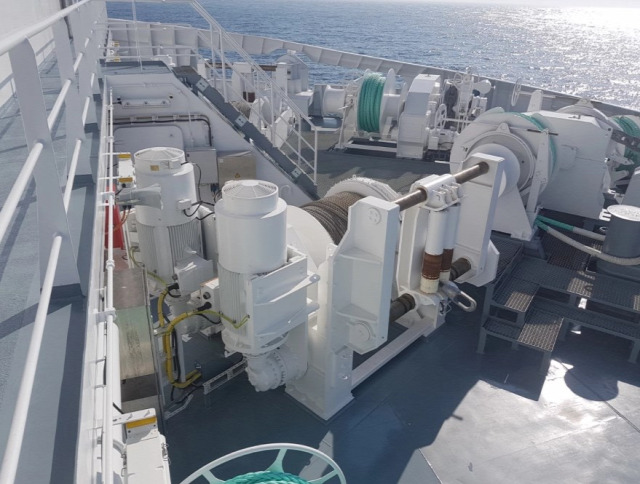Marine winches play a vital role in various maritime operations, providing reliable and robust solutions for handling heavy loads. These powerful devices are strategically installed on board vessels to ensure efficient cargo handling, anchoring, towing, and other critical operations. In this article, we will explore the common locations where marine winches are installed on board vessels, highlighting their significance and functionality.

Foredeck/Forward of the Vessel
One of the primary locations for marine winch installations is the foredeck or forward section of the vessel. This area is commonly used for cargo handling, mooring, and anchoring operations. The winches installed here are often referred to as anchor handling or mooring winches.
Anchor handling winches are responsible for deploying and retrieving anchors and anchor chains, ensuring secure anchoring of the vessel. These winches are designed with high load capacities, precise control mechanisms, and often equipped with anchor handling arms or shark jaws for effective anchor handling operations.
Mooring winches, on the other hand, are used for handling mooring lines and positioning the vessel at the dock or berth. These winches provide the necessary pulling power and control to secure the vessel during mooring operations. They are typically installed at designated positions on the forward deck to ensure optimal line angles and maneuverability.
Aft Deck/Back of the Vessel
The aft deck or back of the vessel is another crucial location for marine winch installations. Here, winches are commonly used for towing, sternline handling, and general cargo handling operations.
Towing winches are installed on the stern or transom of the vessel and are responsible for handling towing lines used to tow or be towed by other vessels. These winches are designed to withstand high loads and provide precise control during towing operations.
Sternline winches are used for handling stern lines, which are used for securing the vessel at the dock or during mooring. These winches ensure proper positioning and securement of the vessel's stern, providing stability and safety during berthing.
Additionally, cargo handling winches may be installed on the aft deck for efficient loading and unloading of cargo. These winches assist in handling cargo slings, hoisting equipment, and other related tasks, contributing to streamlined cargo operations.
Main Deck and Cargo Holds
Marine winches may also be installed on the main deck and within cargo holds, depending on the vessel's specific operations and requirements.
On container ships, winches may be strategically placed on the main deck to handle container lashing systems. These winches assist in securing and tensioning container lashings, ensuring the stability and safety of stacked containers during transit.
Within cargo holds, winches may be installed to facilitate the movement and positioning of cargo. These winches are commonly used on specialized vessels, such as bulk carriers, where they assist in cargo handling, including the deployment of conveyor systems or grab bucket operations for bulk cargo.
Specialized Locations
In addition to the aforementioned areas, marine winches may be installed in specialized locations based on the vessel's specific requirements. These installations cater to specialized operations and equipment, including:
Research Vessels: Winches installed on research vessels are designed to handle specialized equipment such as CTD rosettes, oceanographic instruments, and remotely operated vehicles (ROVs). These winches are typically installed on specific decks or dedicated winch rooms to ensure precision control and protection of sensitive equipment.
Offshore Vessels: Offshore vessels, including supply vessels, accommodation platforms, and offshore construction vessels, may have winches installed in specialized areas for specific tasks such as pipe laying, subsea equipment deployment, or remotely operated vehicle operations. These winches are designed to withstandharsh offshore conditions and perform critical tasks with precision and reliability.
Conclusion
Marine winches are strategically installed on board vessels to support a wide range of maritime operations, including cargo handling, anchoring, towing, and specialized tasks. Whether located on the foredeck, aft deck, main deck, cargo holds, or specialized areas, these winches provide the necessary pulling power, control, and reliability to ensure efficient and safe operations at sea.
Proper placement and installation of marine winches are crucial for their optimal functionality. Vessels are designed with specific locations to accommodate winches based on their intended operations. These installations are carefully considered to ensure ideal line angles, maneuverability, and accessibility.
By strategically installing marine winches on board vessels, operators can enhance operational efficiency, increase safety, and improve overall productivity. These powerful devices play a vital role in facilitating various maritime tasks, contributing to the success of cargo handling, towing operations, and specialized operations in diverse marine environments.

